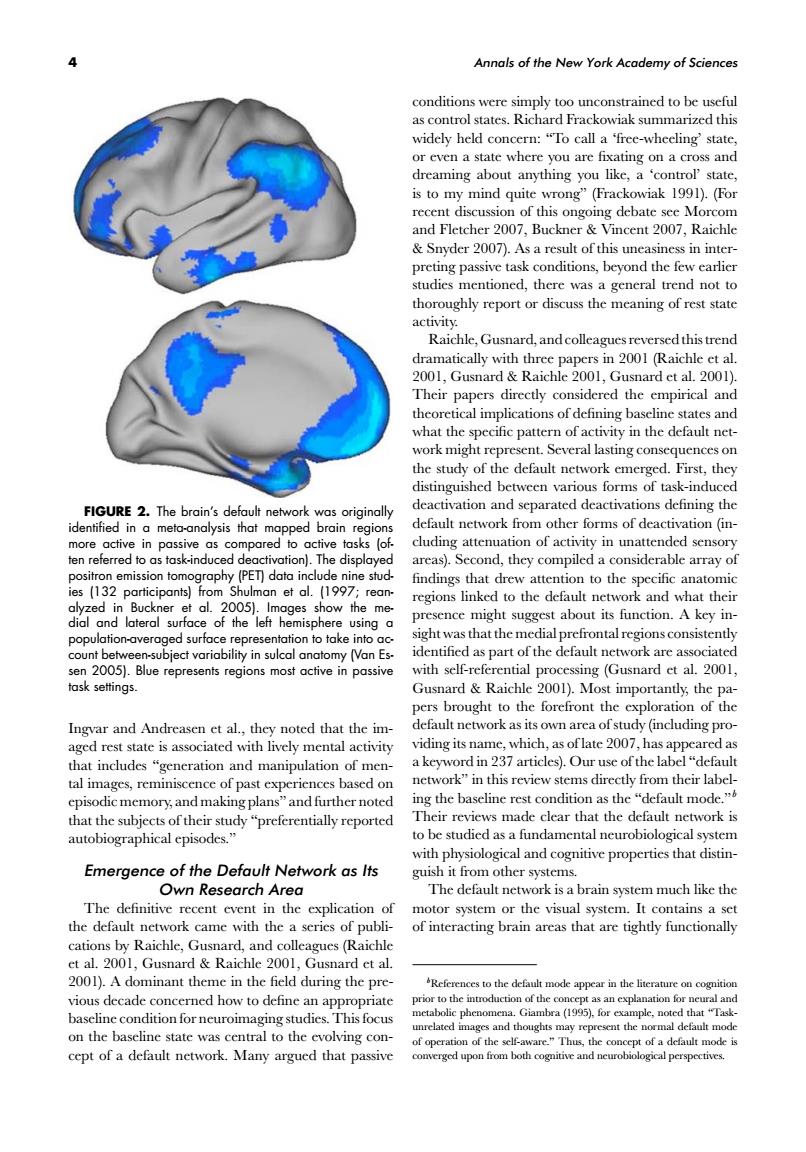正在加载图片...

Annals of the New York Academy of Sciences conditions were simply too unconstrained to be useful as control states.Richard Frackowiak summarized this widely held concern:"To call a'free-wheeling'state, or even a state where you are hxating on a cross and is to my mind quite wrongr and Fletcher 2007.Buckner Vincent 2007.Raichle Snyder 2007).As a result of this uneasiness in inter preting passive task conditions,beyond the few earlier studies mentioned,there was a general trend not to thoroughly report or discuss the meaning of rest state tically ard et al.2001) Their papers directly considered the empirical and theoretical implications of defining baseline states and what the specific pattern of activity in the default net- work might represent.Several lasting consequences on dE. FIGURE 2.The brain's default network was originally default network from other forr cluding attenuation of activity in unattended sensory The areas).Second,they compiled a considerable array of egions lin ork and what thei alzed in Buckner e al)mges show the st a n.A key ir ulation-ave tthe m the defa 20051.Blue regions m sing (Gusnard ct al.2001 task seltings. Gusnard Raichle 2001).Most importantly,the pa- Ingvar and Andreasen et al..they noted that the im. aged rest state is associated with lively mental activity nding its nan me,which,as oflate 2007 that includes "generation and manipulation of men es).u 1.1 tal images,reminiscence of past experiences based on ng plan ntially reported to be studied as a fundamental neurobiological system with physiological and cognitive properties that distin- Emergence of the Default Network as Its Own Research Area work is a brain system much like the ations by Raichle Gu 2001).A dominant theme in the field during the pre- in the liter vious decade concerned how to define an appropriate baseline condition for ncuroimaging studies This focus r(1995). on the ving con- 4 Annals of the New York Academy of Sciences FIGURE 2. The brain’s default network was originally identified in a meta-analysis that mapped brain regions more active in passive as compared to active tasks (often referred to as task-induced deactivation). The displayed positron emission tomography (PET) data include nine studies (132 participants) from Shulman et al. (1997; reanalyzed in Buckner et al. 2005). Images show the medial and lateral surface of the left hemisphere using a population-averaged surface representation to take into account between-subject variability in sulcal anatomy (Van Essen 2005). Blue represents regions most active in passive task settings. Ingvar and Andreasen et al., they noted that the imaged rest state is associated with lively mental activity that includes “generation and manipulation of mental images, reminiscence of past experiences based on episodic memory, and making plans” and further noted that the subjects of their study “preferentially reported autobiographical episodes.” Emergence of the Default Network as Its Own Research Area The definitive recent event in the explication of the default network came with the a series of publications by Raichle, Gusnard, and colleagues (Raichle et al. 2001, Gusnard & Raichle 2001, Gusnard et al. 2001). A dominant theme in the field during the previous decade concerned how to define an appropriate baseline condition for neuroimaging studies.Thisfocus on the baseline state was central to the evolving concept of a default network. Many argued that passive conditions were simply too unconstrained to be useful as control states. Richard Frackowiak summarized this widely held concern: “To call a ‘free-wheeling’ state, or even a state where you are fixating on a cross and dreaming about anything you like, a ‘control’ state, is to my mind quite wrong” (Frackowiak 1991). (For recent discussion of this ongoing debate see Morcom and Fletcher 2007, Buckner & Vincent 2007, Raichle & Snyder 2007). As a result of this uneasiness in interpreting passive task conditions, beyond the few earlier studies mentioned, there was a general trend not to thoroughly report or discuss the meaning of rest state activity. Raichle,Gusnard, and colleaguesreversed thistrend dramatically with three papers in 2001 (Raichle et al. 2001, Gusnard & Raichle 2001, Gusnard et al. 2001). Their papers directly considered the empirical and theoretical implications of defining baseline states and what the specific pattern of activity in the default network might represent. Several lasting consequences on the study of the default network emerged. First, they distinguished between various forms of task-induced deactivation and separated deactivations defining the default network from other forms of deactivation (including attenuation of activity in unattended sensory areas). Second, they compiled a considerable array of findings that drew attention to the specific anatomic regions linked to the default network and what their presence might suggest about its function. A key insightwasthat the medial prefrontalregions consistently identified as part of the default network are associated with self-referential processing (Gusnard et al. 2001, Gusnard & Raichle 2001). Most importantly, the papers brought to the forefront the exploration of the default network as its own area of study (including providing its name, which, as of late 2007, has appeared as a keyword in 237 articles). Our use of the label “default network” in this review stems directly from their labeling the baseline rest condition as the “default mode.”b Their reviews made clear that the default network is to be studied as a fundamental neurobiological system with physiological and cognitive properties that distinguish it from other systems. The default network is a brain system much like the motor system or the visual system. It contains a set of interacting brain areas that are tightly functionally bReferences to the default mode appear in the literature on cognition prior to the introduction of the concept as an explanation for neural and metabolic phenomena. Giambra (1995), for example, noted that “Taskunrelated images and thoughts may represent the normal default mode of operation of the self-aware.” Thus, the concept of a default mode is converged upon from both cognitive and neurobiological perspectives